Advancing U.S. Diplomacy in the Arctic
Despite challenges posed by Russia and China, the Biden administration has a chance to further constructive, cooperative relations among nations concerned with the Arctic.
BY DAVID BALTON

David Balton (right) chairs a Senior Arctic Officials meeting in Juneau, Alaska, in March 2017.
Courtesy of David Balton
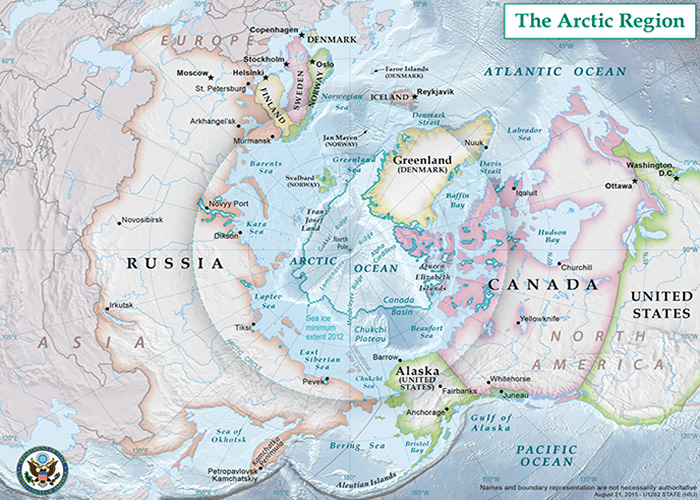
U.S. Department of State
During the Cold War, attention paid to the Arctic focused primarily on national security matters. Beginning in the mid-1990s, governments broadened their gaze to consider the economic potential—and the environmental challenges—of the region. Particularly in the last decade, as a warming climate ushered in profound environmental changes in the region, Arctic governments and residents have scrambled to stay ahead of emerging issues.
Coastlines are eroding, sea ice is vanishing, and permafrost is thawing. These phenomena and others are already causing serious problems in the Arctic and point to trouble ahead for other parts of the planet. At the same time, a more open Arctic Ocean is sparking ever greater interest in potential resource development, shipping and tourism, among other opportunities.
As a result, the Arctic has witnessed a remarkable spurt in the numbers of international institutions and arrangements designed to manage expanding human activity in the region, and deepen human understanding of it. Despite serious tensions between Russia and other Arctic nations concerning other issues and parts of the world, Arctic governments have largely chosen to compartmentalize the region, setting those tensions aside in favor of cooperating in pursuit of shared interests.
That is, until recently. During the last two years of the Trump administration, the spirit of international cooperation that has largely characterized Arctic affairs came under threat. First, the United States reversed course on climate policies and found itself seriously out of step with other Arctic governments in that regard. At the same time, Russia stepped up its efforts to rebuild its military infrastructure and expand its capabilities in the Arctic, and engaged in provocative actions against the West. Finally, China declared itself a “near-Arctic state” and sought to increase its influence in the region in ways that have caused concern.
Tensions over climate change continued to plague the body through the end of the Trump administration.
Despite the ongoing challenges that Russia and China pose, the Biden administration has taken office with a chance to renew constructive, cooperative relations among nations concerned with the Arctic. The decision to rejoin the Paris climate agreement represents a first step in that direction, but most of the journey still lies ahead. This article focuses on one venue—the Arctic Council—in which a key part of that journey can take place.
Creation of the Arctic Council
The eight nations of the Arctic—Canada, Denmark, Finland, Iceland, Norway, Russia, Sweden and the United States—established the Arctic Council in 1996 through a nonbinding instrument known as the Ottawa Declaration. The council, though not a formal international organization with legal personality and assessed budgetary contributions, has served, in the words of the declaration, as a high-level forum to promote “cooperation, coordination and interaction among the Arctic states, with the involvement of the Arctic indigenous communities and other Arctic inhabitants, on common Arctic issues, in particular issues of sustainable development and environmental protection in the Arctic.”
The inclusion of Arctic Indigenous peoples in virtually all aspects of the council’s work makes this forum unique. Six groups of “Permanent Participants,” representing Indigenous communities throughout the region, take part in council meetings in their own name and right, not as part of national delegations. Decisions of the council, though in principle made only by consensus of the governments, in practice also require the consensus of the permanent participants as well.
The Arctic Council, largely through its six standing working groups on various aspects of monitoring and protecting the Arctic, has produced groundbreaking analyses of Arctic climate change, biodiversity, shipping and countless other topics. At its biennial ministerial meetings, which all U.S. Secretaries of State have attended since 2011, the council adopts far-reaching recommendations on an extraordinary range of issues.
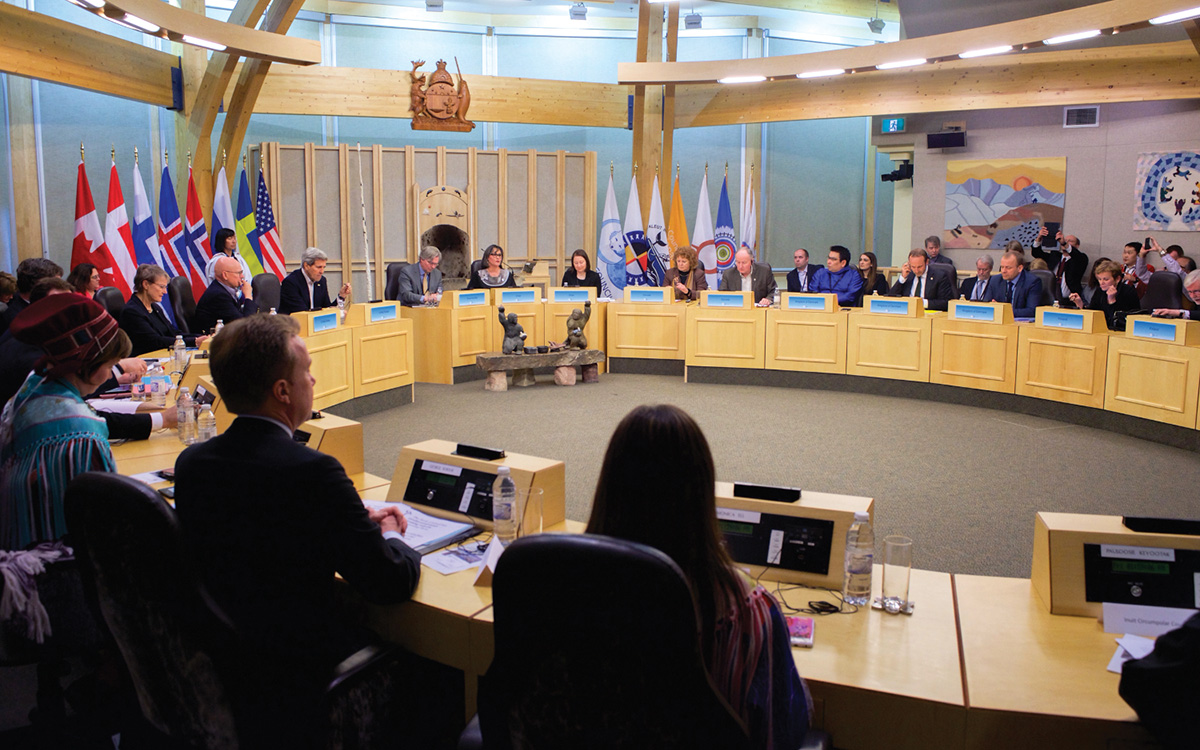
A ministerial meeting of the Arctic Council takes place in Iqaluit, Canada, in April 2015.
Arctic Council
U.S. Leadership in the Council
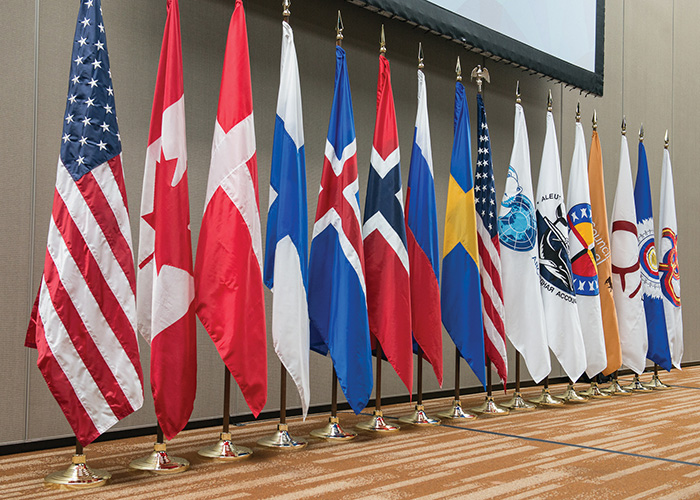
The flags of the eight Arctic Council member-states and six Indigenous Permanent Participant organizations.
Linnea Nordstöm / Arctic Council Secretariat
The chairmanship of the Arctic Council rotates every two years among its eight members. The United States most recently chaired the council from May 2015 to May 2017, a term that spanned two U.S. administrations. Indeed, when Secretary of State Rex Tillerson presided over the Arctic Council ministerial meeting in Fairbanks, Alaska, in 2017, he brought to fruition a set of programs and projects that the Obama administration had launched two years earlier.
The United States has found many ways to exercise leadership within the council even while not leading the body as a whole. Experts from the United States have very frequently spearheaded the work that the council undertakes, such as the 2004 Arctic Climate Impact Assessment and the 2009 Arctic Marine Shipping Assessment.
Three times in the past decade, the council created task forces to negotiate new treaties for the Arctic region. In each case, the United States co-led these task forces, which produced in quick succession (at least by the normal standards of diplomacy) the 2011 Agreement on Cooperation on Aeronautical and Maritime Search and Rescue in the Arctic, the 2013 Agreement on Cooperation on Marine Oil Pollution Preparation and Response in the Arctic, and the 2017 Agreement on Enhancing International Scientific Cooperation in the Arctic.
It is worth noting that Russia also co-chaired each of these task forces. Indeed, the success of each endeavor depended substantially on cooperation between Russia and the United States in working through the challenges that each group confronted. Having served as U.S. co-chair for the first two task forces, I can say from experience that successful leadership of the negotiations required a great deal of behind-the-scenes communication and trust, which occurred despite rising bilateral tensions at the time.
Similar communication and trust also existed between the American and Russian co-chairs of the third task force, which was established after the Russian invasion of Crimea and the resulting international sanctions. This demonstrates the willingness of the two governments in those years to “compartmentalize” the Arctic and pursue cooperation there despite conflicts elsewhere.
Breakdown in 2019
In May 2019, Secretary of State Mike Pompeo traveled to Finland to participate in the Arctic Council ministerial meeting in Rovaniemi that would conclude Finland’s chairmanship and launch the incoming Icelandic chairmanship. Before reaching Rovaniemi, he stopped in Helsinki to deliver a well-publicized speech about the region.
There, Secretary Pompeo declared that the Arctic “has become an arena for power and competition … complete with new threats to the Arctic and its real estate, and to all of our interests in that region.” He raised particular concerns about Chinese “aggressive behavior” in the Arctic. He also sharply criticized Moscow, citing a pattern of aggressive Russian behavior in the region: “Russia is already leaving snow prints in the form of army boots.” And for good measure, he noted the “long-contested feud” between the United States and Canada concerning the rights of vessels to transit the Northwest Passage.
The following day, at the ministerial meeting itself, the Arctic Council failed—for the first time in its history—to reach agreement on a declaration, the biennial document that summarizes the accomplishments of the outgoing chairmanship and provides a mandate for the new chairmanship. Most accounts of the event correctly lay the blame for this failure at the feet of the United States, for rejecting language in the draft declaration concerning climate change in the Arctic that all other Arctic Council members believed to be essential.
Afterward, the council struggled to move forward. Tensions over climate change continued to plague the body through the end of the Trump administration. The coronavirus pandemic has also required the council to meet only virtually, which poses hardships for a circumpolar group whose participants live in almost all time zones. Despite these challenges, the government of Iceland has done a creditable job of keeping the council functioning as well as possible, making progress in several areas.
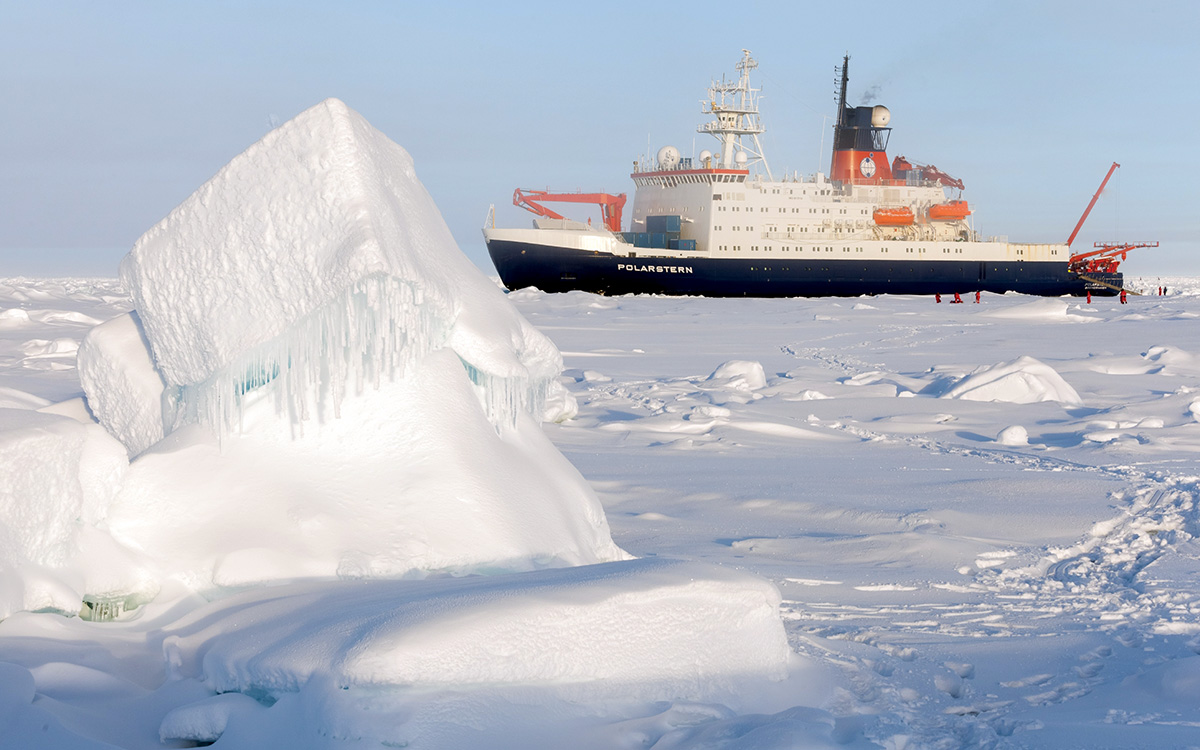
A German research vessel floats among the icebergs in the central Arctic Ocean in 2015.
Mario Hoppman
Looking Ahead
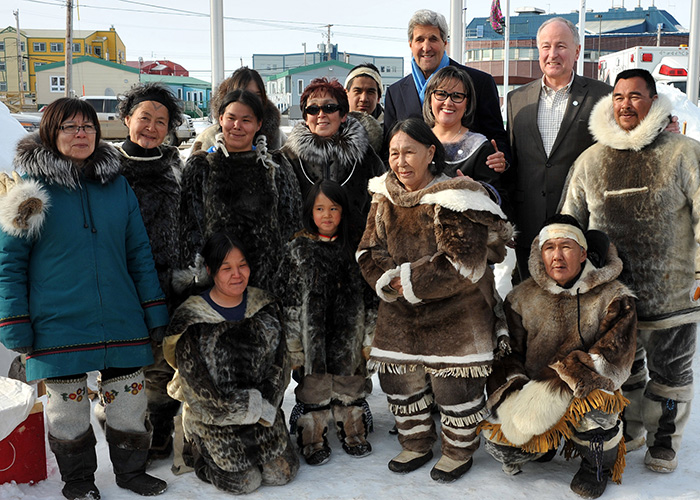
During the 2015 Arctic Council ministerial meeting in Iqaluit, Canada, local Inuit residents join U.S. Secretary of State John Kerry and Minister for the Arctic Council Leona Aglukkaq.
Arctic Council Secretariat
The Biden administration now has the chance to change the narrative within the Arctic Council. Most obviously, it can—and almost certainly will—join other member-states and permanent participants in using the council as a venue in which to combat the causes and effects of climate change. For example, the United States can contribute to renewed efforts by the group to reduce emissions of black carbon (soot) in the region. These particles settle on the Arctic’s white surfaces, turning them dark and reducing their reflectivity of sunlight, which in turn causes those surfaces to grow warmer. The council previously set an “aspirational goal” to reduce black carbon; now should be the time to take concrete measures to meet that goal.
More generally, the United States can once again become a leader in the many programs and projects that relate in some way to the warming Arctic climate. During the Trump administration, officials who represented the United States in the council had some leeway to allow such work to move forward, so long as it stayed under the political radar screen. Now, with the full support of the White House, U.S. representatives to the council can press their counterparts to take bold action and bring to bear the significant expertise and resources of the United States in support of such action.
The Biden administration should also consider proposals to create the position of “Arctic ambassador” or the equivalent. There is some precedent for creating such a position. During the Obama administration, Secretary of State John Kerry appointed Robert Papp, a former commandant of the U.S. Coast Guard, as “Special Representative for the Arctic.” In that role, Admiral Papp oversaw preparations for, and execution of, the 2015-2017 U.S. chairmanship of the Arctic Council. But a career civil servant continued to serve as the senior U.S. official representing our nation in the Arctic Council.
More recently, Secretary Pompeo appointed James DeHart, a Foreign Service officer, as “U.S. Coordinator for the Arctic Region.” But he, too, does not represent the United States in the Arctic Council—that responsibility now rests with Meredith Rubin, an FSO. It may be time to rethink these arrangements, and raise the level of U.S. representation in the council to the ambassadorial level, a step that other Arctic Council members took years ago.
The United States should also urge the other Arctic states to strengthen the council itself. Despite its remarkable evolution, the Arctic Council lacks a long-term strategic plan, adequate and predictable funding, and a consolidated secretariat. Its current structure, put into place in 1996, needs revision to enable the council to respond to current and future needs of the region. It should also become more accountable, by instituting a practice in which its members regularly report on their implementation of decisions that the body has taken.
Russia takes over as Arctic Council chair this month and may not have much appetite for taking any of these steps. Then again, Moscow will want to claim success at the end of its two-year term, and may be open to one or more of these ideas after all. Even if it is not, efforts that the Biden administration initiate now could bear fruit beginning in 2023, when the Arctic Council will embark on a six-year span during which a succession of Scandinavian governments (Denmark, Norway and Sweden) hold the chair.
Beyond the Arctic Council
Finally, the Biden administration should pursue ways to improve governance of the region—and particularly of the Arctic Ocean—outside the Arctic Council. The region will need an architecture that is more robust than the council, with its inherent limitations in terms of authority and structure, can provide.
As noted above, melting sea ice has made the Arctic Ocean dramatically more accessible. Commercial shipping has already increased, particularly along Russia’s Northern Sea Route, with further increases expected. Yet the Arctic Ocean remains poorly understood and poorly charted. Current arrangements and rules relating to the Arctic Ocean—including those generated by the Arctic Council, the International Maritime Organization’s Polar Code, the 2018 Arctic Fisheries Agreement and the Arctic Coast Guard Forum—are not likely to prove either sufficiently strong or sufficiently well coordinated to manage increasing human activity there in the coming years.
The United States can and should lead efforts to improve this regime in a variety of ways. In that regard, the initial meeting between President Joe Biden and Prime Minister Justin Trudeau included a focus on the Arctic region, and committed the United States and Canada to work together on “Arctic governance,” among other things. To strengthen Arctic governance, the two governments might begin by jointly proposing the creation of a marine science body for the Central Arctic Ocean and, sometime thereafter, a marine management body for the Central Arctic Ocean.
Read More...
- “Getting into the Game: America’s Arctic Diplomacy,” by Ásgeir Sigfússon, The Foreign Service Journal, November 2015
- “There Is No Scramble for the Arctic,” by Thomas Mayers and Amy Myers Jaffe, Foreign Affairs, July 2020
- “The Secretary Visits the Arctic,” Miguel Rodrigues, The Foreign Service Journal, November 2015





